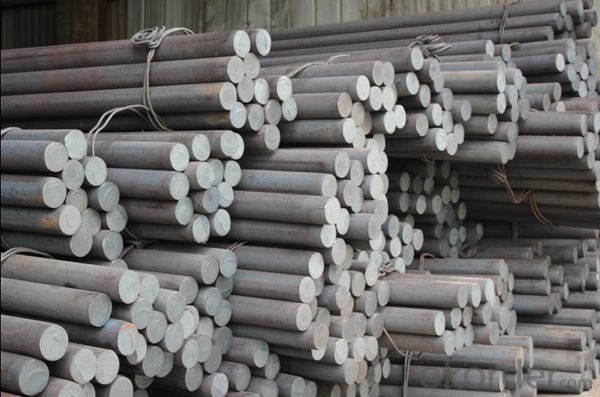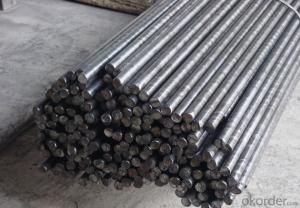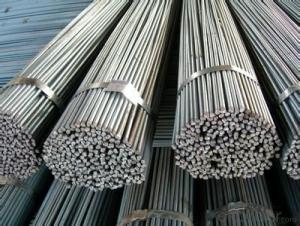Hot Rolled Round Steel Bars with Cr A36, Q235, SS400
- Loading Port:
- Tianjin
- Payment Terms:
- TT OR LC
- Min Order Qty:
- 25 m.t.
- Supply Capability:
- 200000 m.t./month
OKorder Service Pledge
OKorder Financial Service
You Might Also Like
Item specifice
Product Description:
Hot Rolled Round Steel Bars with Cr A36, Q235, SS400 is used for manufacturing ball, roller bearing steel and rings. Bearing in work is under great pressure and friction, so have high demands bearing steel and hardness and resistance, and high elastic limit.
Bearing steels are used for ball and roller bearing applications and are comprised of low carbon steels and high carbon through harden able steel.
For example, bearing ring, steel rolling mill, machinery, 100Cr6 bearing steel ball is widely used in high-speed and low-noise bearing, bicycle, motorcycle, automobile, bags electronically.
Product Applications:
Hot Rolled Round Steel Bars with Cr A36, Q235, SS400 are ideal for structural applications and are widely used in the construction of buildings and bridges, and the manufacturing, petrochemical, and transportation industries.
1. Steel round bar products is used in construction and a large number of architectural and engineering structures. And it can be used in production of handrail, windows, machinery, telecom and curtain wall.
2. It can be used in the fields like metal mines, cement plants, water coal slurry, power stations and chemical industry.
3. Besides, we can supply some especial material steel round bar that can be used for main shaft of steamer, hummer shank, with big section and supper force.
4. Recommended watchcase factory, screw factory and other cold stamping products industry use.
Product Advantages:
OKorder's Hot Rolled Round Steel Bars with Cr A36, Q235, SS400 are durable, strong, and resist corrosion.
1. The steel in which the main interstitial alloying constituent is carbon in the range of 0.12–2.0%.
2. As the carbon percentage content rises, steel has the ability to become harder and stronger through heat treating; however it becomes less ductile.
3. Regardless of the heat treatment, higher carbon content reduces weld ability. In carbon steels, the higher carbon content lowers the melting point.
4. Quality should be in conformity with the specification of the manufacturer. Quantity and packing conditions should be in conformity with the term in the contract.
Main Product Features:
· Premium quality
· Prompt delivery & seaworthy packing (30 days after receiving deposit)
· Corrosion resistance
· Can be recycled and reused
· Mill test certification
· Professional Service
· Competitive pricing
Specifications of Hot Rolled Round Steel Bars with Cr A36, Q235, SS400
1. Grade: Q235, A36, SS400, S235JR
2. Feature: Unbreakable, grinding resistant and high impact value
3. Diameter: 8mm-150mm
4. Performance: Mainly for civil construction
5. Characteristics: Even hardness, no deformation, no breaking, no mal-roundness
6. Technique: Hot rolled
7. Mass: Mass (kg/m) = Diameter (mm) × Diameter (mm) × 0.00617
Packaging & Delivery of Hot Rolled Round Steel Bars with Cr A36, Q235, SS400
Packaging Detail: All goods are packed in bundle with steel strips and shipped by break bulk vessel or container (depend on target market and different ports)
Delivery Detail: 45 days
Trade terms: FOB, CFR, CIF
MOQ: 25 tons per specification; we can negotiate the quantity if the specification is normal or we have stock of one specification.
Weight: The price invoicing on theoretical weight basis or actual weight basis depends on customer’s request.
Shipment: The shipment of bulk break or container is depends on customer’s request and the situation of the port of destination.
Documents given: Full set of original clean on board bill of lading; Original signed commercial invoice; Original packing list; Policy of insurance; Certificate of origin and what the target market needs.
Production Flow of Hot Rolled Round Steel Bars with Cr A36, Q235, SS400
Material prepare (billet) — heat up — rough rolling — precision rolling — cooling — packing — storage and transportation
FAQ:
Q1: The products are invoicing on theoritical weight or on actual weight?
A1: We can do it in both manners, according to the customers' request.
Q2: What is the normal tolerance of Hot Rolled Round Steel Bars with Cr A36, Q235, SS400?
A2: Normally 3%-5%, but we can also produce the goods according to the customers' requests.
Q3: How soon can we receive the product after purchase?
A3: Within three days of placing an order, we will begin production. The specific shipping date is dependent upon international and government factors, but is typically 7 to 10 workdays.

- Q:Can a steel square be used for measuring board thickness?
- No, a steel square is typically not used for measuring board thickness. It is primarily used for checking angles and making precise measurements in woodworking and carpentry. A more suitable tool for measuring board thickness would be a caliper or a thickness gauge.
- Q:How do you use a steel square to measure board widths at different points?
- To use a steel square to measure board widths at different points, place the square's long side against the edge of the board and ensure it is perpendicular to the surface. Then, slide the square along the board, aligning it with different points where you want to measure the width. This will give you accurate measurements at each point along the board.
- Q:Can a steel square be used for retaining wall layout and construction?
- Yes, a steel square can be used for retaining wall layout and construction. A steel square, also known as a framing square, is a versatile tool that can be used for a variety of carpentry and construction tasks. It is particularly useful for measuring and marking right angles, which is essential for laying out a retaining wall accurately. When constructing a retaining wall, it is crucial to ensure that all angles are properly measured and marked to ensure the wall is level and structurally sound. A steel square can be used to measure and mark right angles, which are necessary for laying out the base and corners of the wall. This ensures that the wall is built straight and in line with the desired layout. Additionally, a steel square can be used to check for squareness during the construction process. By placing the square against the corners and edges of the wall, you can verify that they are at perfect right angles. This helps to maintain the integrity and stability of the retaining wall. In summary, a steel square is a useful tool for retaining wall layout and construction as it enables accurate measurement and marking of right angles. It helps ensure that the wall is built straight, level, and structurally sound.
- Q:How do you use a steel square to measure and mark 33.75-degree angles?
- To use a steel square to measure and mark a 33.75-degree angle, follow these steps: 1. Begin by setting your steel square on a flat surface, ensuring it is aligned properly. 2. Locate the 45-degree angle on the square, which is usually marked by a small notch or line. 3. Align the square so that the 45-degree angle line is parallel to the edge of the material or surface you are working with. 4. Use a protractor or angle measuring tool to measure and mark a 33.75-degree angle on the steel square. 5. Once you have determined the correct angle, use a marker or pencil to make a small mark on the steel square at the desired angle measurement. 6. From the mark you made, extend a straight line across the material or surface you are working on using the square as a guide. 7. Double-check your measurements and marks to ensure accuracy before proceeding with any cutting or further work. By using a steel square and carefully measuring and marking the desired 33.75-degree angle, you can ensure precision when working with various materials or projects.
- Q:Can a steel square be used for tile floor medallion layout?
- Yes, a steel square can be used for tile floor medallion layout. A steel square is a versatile and precise tool that can be used for various layout tasks, including tile installation. It can help ensure accurate angles and measurements, which are crucial for creating a visually appealing and well-aligned tile medallion. However, it is important to note that a steel square may not be the only tool needed for this task. Other tools such as a tape measure, chalk line, and level may also be required to ensure proper layout and installation.
- Q:How do you use a steel square to measure and mark 78.75-degree angles?
- To measure and mark a 78.75-degree angle using a steel square, you would first align one edge of the square with the line or surface you want to mark. Then, rotate the square until the other edge aligns with the desired angle, which in this case would be 78.75 degrees. Once aligned, you can use a pencil or marker to mark the angle on the material or surface you are working on.
- Q:Can a steel square be used for checking the squareness of a band saw table?
- Yes, a steel square can be used for checking the squareness of a band saw table.
- Q:What are some common uses of a steel square in woodworking joinery?
- A steel square, also known as a framing square or carpenter's square, is an essential tool in woodworking joinery. It is primarily used for measuring, marking, and checking right angles in woodworking projects. Here are some common uses of a steel square in woodworking joinery: 1. Marking and measuring right angles: The steel square is used to mark and measure 90-degree angles accurately. It helps in marking square lines, guiding saw cuts, and ensuring precise joinery. 2. Checking for squareness: Woodworkers use a steel square to check if a joint or corner is square. By placing the square against the joint or corner, they can quickly determine if it is perfectly square or needs adjustment. 3. Determining and transferring angles: Steel squares often have additional markings that allow woodworkers to determine and transfer angles other than 90 degrees. This ability is particularly useful for creating bevels, mitered corners, and complex joinery. 4. Layout and marking: Steel squares are used for laying out and marking components of a woodworking project. They help in transferring measurements accurately, marking cut lines, and ensuring precise positioning of joints and connections. 5. Guiding hand saw cuts: Woodworkers often use a steel square as a guide to ensure straight and accurate cuts with a hand saw. By aligning the square's edge with the cut line, they can maintain a consistent angle and achieve clean, precise cuts. 6. Checking for flatness: A steel square can also be used to check the flatness of a surface or board. By placing the square across the wood's width or length, woodworkers can identify any twists, bows, or warping that may affect the overall quality of the joinery. 7. Creating perpendicular lines and notches: The steel square is handy for creating perpendicular lines and notches in woodworking projects. It assists in aligning and marking where joinery elements such as mortises, tenons, or dovetails should be cut. Overall, the steel square is a versatile tool that plays a crucial role in ensuring accuracy, precision, and quality in woodworking joinery. Its multiple uses make it indispensable for woodworkers of all levels, from hobbyists to professionals.
- Q:How do you use a steel square to measure and mark 120-degree angles?
- To use a steel square to measure and mark 120-degree angles, you need to align the 60-degree angle on the square with one of the sides of the angle you want to measure. Then, mark a point where the other side of the angle intersects the steel square. Finally, use a straight edge to connect this point with the vertex of the angle, creating a 120-degree angle.
- Q:How do you use a steel square to determine the height of an object?
- To use a steel square to determine the height of an object, you can follow these steps: 1. Place the steel square on a flat surface, ensuring that it is level and stable. 2. Position the object whose height you want to measure next to the steel square. 3. Align the long side of the steel square vertically against the side of the object. Make sure the square is flush against the object's surface. 4. Look at the measurement markings on the steel square. The height of the object will be indicated by the point where the top edge of the object intersects with the measurement scale on the square. 5. Take note of the measurement indicated on the steel square, which represents the height of the object. Note that if the object has an irregular shape or is not flat, you may need to adjust your positioning to find a consistent reference point to measure from. Additionally, it is important to ensure the steel square is accurately calibrated and the measurements are easy to read to obtain precise results.
1. Manufacturer Overview |
|
|---|---|
| Location | |
| Year Established | |
| Annual Output Value | |
| Main Markets | |
| Company Certifications | |
2. Manufacturer Certificates |
|
|---|---|
| a) Certification Name | |
| Range | |
| Reference | |
| Validity Period | |
3. Manufacturer Capability |
|
|---|---|
| a)Trade Capacity | |
| Nearest Port | |
| Export Percentage | |
| No.of Employees in Trade Department | |
| Language Spoken: | |
| b)Factory Information | |
| Factory Size: | |
| No. of Production Lines | |
| Contract Manufacturing | |
| Product Price Range | |
Send your message to us
Hot Rolled Round Steel Bars with Cr A36, Q235, SS400
- Loading Port:
- Tianjin
- Payment Terms:
- TT OR LC
- Min Order Qty:
- 25 m.t.
- Supply Capability:
- 200000 m.t./month
OKorder Service Pledge
OKorder Financial Service
Similar products
New products
Hot products
Related keywords

























